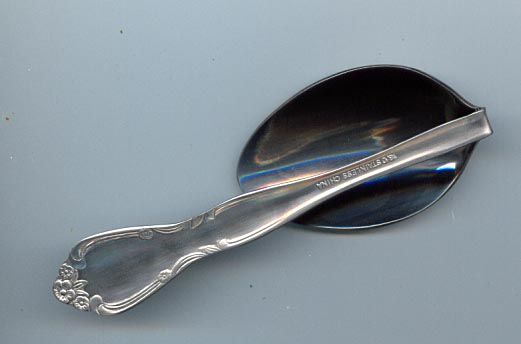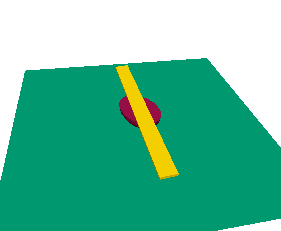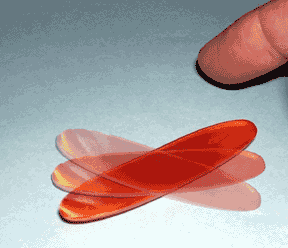
 |
Most toy stores have plastic versions, but you can make one out of a spoon (click on the photo above) or a stick of wrapped chewing gum, or find one doing double duty as your telephone handset or remote control. The device is usually called a “rattleback” or “Celt.” What it is, is an asymmetric rigid rotor, and it has a delightful property. If placed on any smooth, clean surface and spun, the rattleback will only spin in one direction! Storebought rattlebacks, small shards of clear plastic, will only spin counterclockwise seen from above. If you try to spin one clockwise, it will start rocking rapidly up and down, stop rotating, and start spinning in the opposite direction!
One of the simplest homemade rattlebacks consists of the bowl of a plastic spoon with a small screw taped to one edge, as seen here. Or try a bent spoon, as also seen at the top of the page, and discover with a little experimentation that you can form an object which will continually reverse direction as it spins, as seen here. The type of remote control that will work is seen here. The sort of telephone handset that will work is seen here. Forming a rattleback from a stick of unwrapped chewing gum is demonstrated here, and shown performing in slow motion here. Also look here, for a folk-art rattleback.
Some brief writeups can be seen here, and here.

Rattleback made from bowl of plastic spoon, and plastic ruler. (If it is not animated, hit reload.) |

The usual toystore rattleback. |
OK, what's going on? A lopsided rigid body with a smooth round bottom, resting on a hard clean surface, has basically four different types of motion it can execute. (A) It can spin clockwise. (B) It can rock up and down. (C) It can spin counterclockwise. And, (D), it can rock from side to side. For the storebought plastic rattleback, the mode (D) is stable, and will continue until the object comes to rest. Mode (C) is fairly stable but slowly converts or evolves into mode (D), just before the object comes to rest. Mode (B) will convert or evolve quickly into mode (C)... if you press down on one end of the rattleback to make it rock, it will start spinning... and if it spins fast enough will display mode (D) just as it's coming to rest. Finally, if you start the object spinning clockwise, the mode (A) will almost at once convert to mode (B), rocking, and then to mode (C), the opposite rotation, and eventually mode (D). This conversion, which physicists call coupling, usually goes in only one direction... here (A) to (B) to (C) to (D).
It all depends on the shape... rattlebacks made from metal spoons can easily be configured so that the clockwise and counterclockwise modes are equally stable, so that if the spoon is spun in any direction it will stop, reverse, spin a while, then stop again, then reverse again, continuing the cycle for as long as friction permits.
Warning! Kids, do not take a spoon out of your mother's or grandmother's stash to form your rattleback. You are likely to discover that the chosen spoon was a priceless and irreplacable silver heirloom, and to have a large hurting place created somewhere on your body as a direct result of your choice. You can find a restaurant-style spoon at the local supermarket for less than a dollar, which mother will let you twist to your heart's content. Is this how Uri Geller got his start?